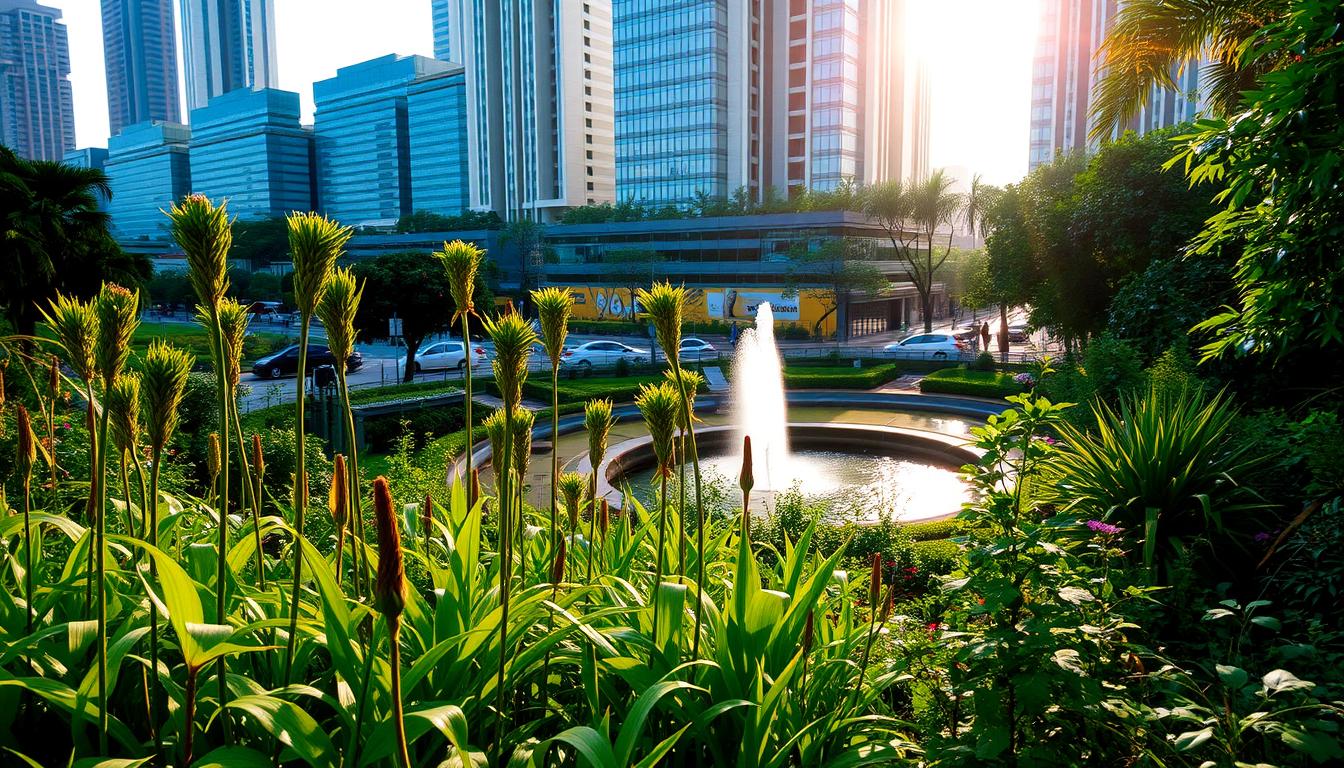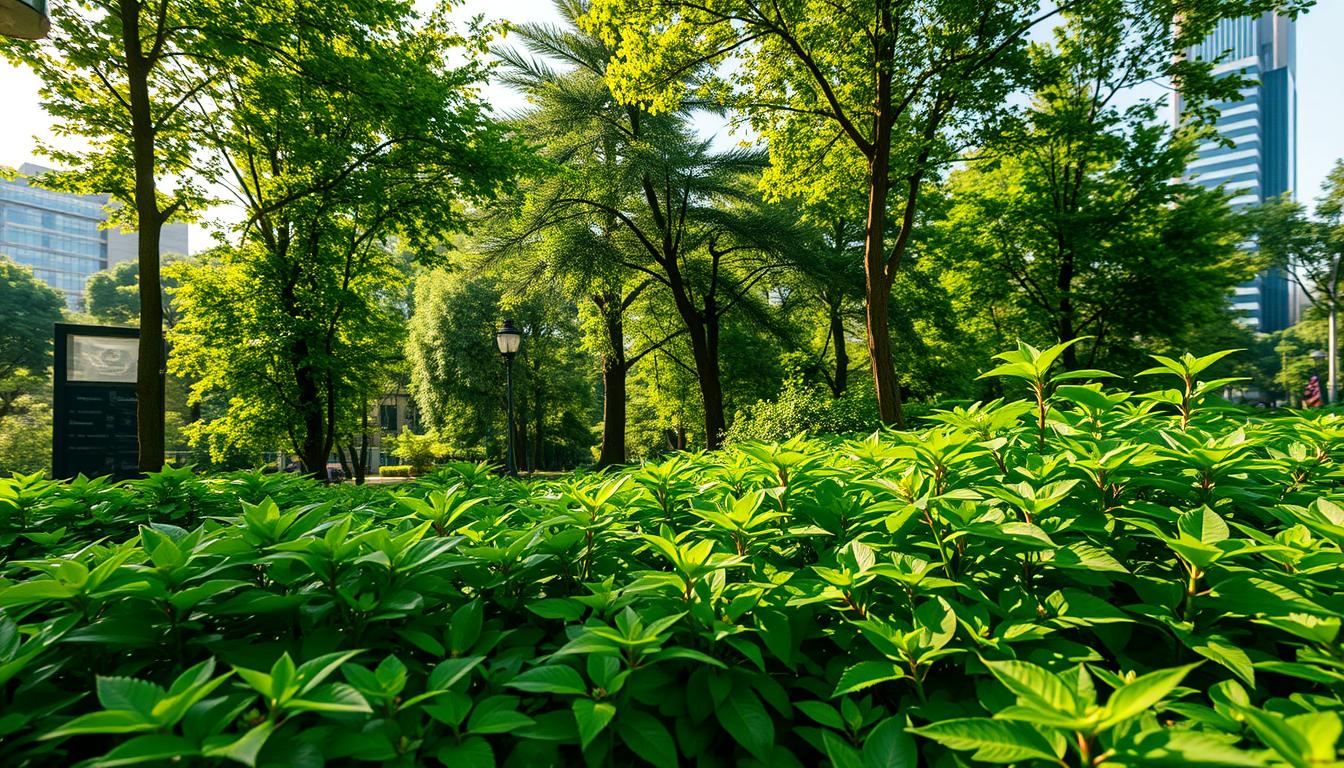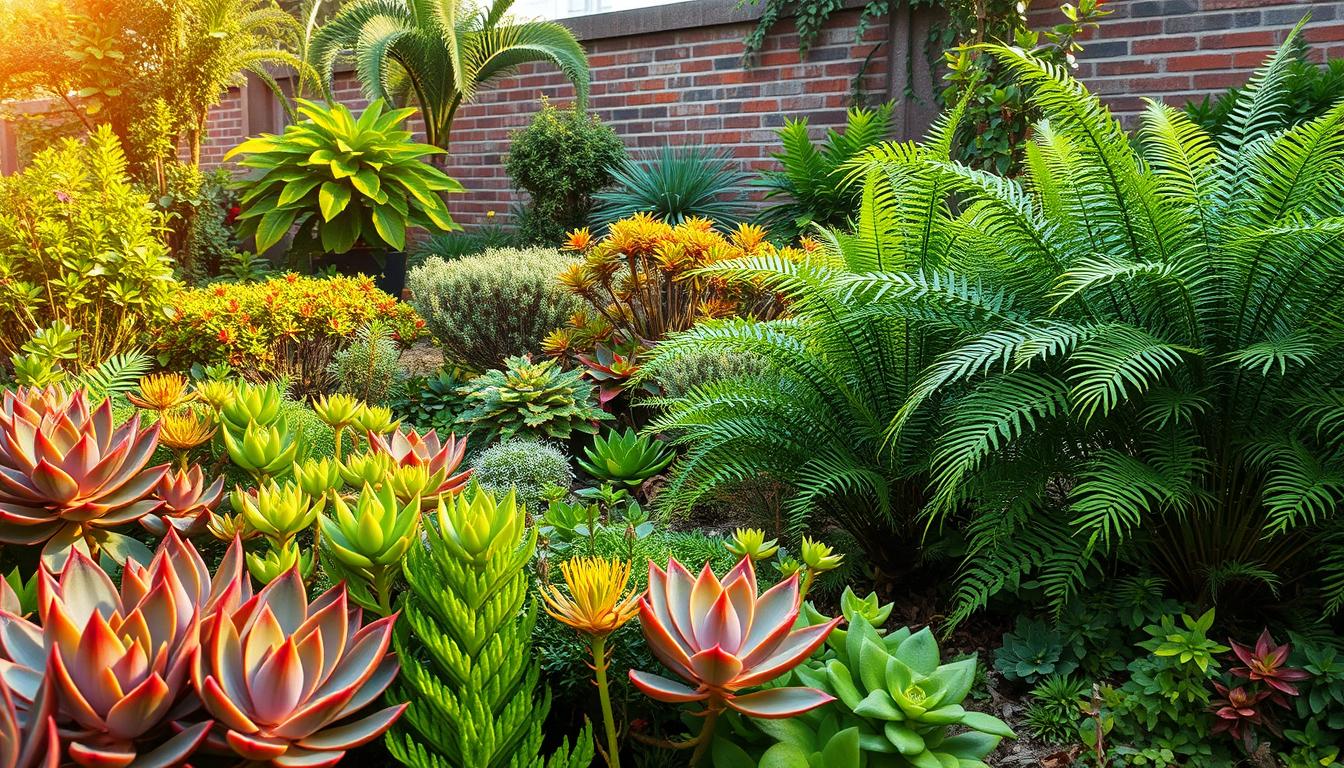
City pollution is a big worry for gardeners and plant lovers. As cities grow, the air, water, and soil quality gets worse. This hurts plants’ health and makes it hard for them to survive. We need to act fast to keep our green spaces safe.
To help our plants thrive, we must know how city pollution affects them. We also need to find ways to fight it. This article will show you how to protect plants from city pollution. We want them to stay healthy and strong.
Table of Contents
ToggleKey Key Takeaways Key Takeaways
- Understand how city pollution affects plants.
- Effective strategies to protect plants plants.
- Practical tips for a healthier, more resilient garden garden.
- garden.
👉 Also Read: DIY Vertical Herb Garden Using Plastic Bottles
Understanding Urban Pollution and Its Impact on Plants
It’s important to understand how urban pollution affects plants. This knowledge helps us find ways to protect them. By learning about urban pollution’s effects, we can take better care of plants.
Common Types of Urban PollutantsPollutants
Urban areas have many pollutants that harm plants. The main pollutants are particulate matter (PM), nitrogen ozone (O3), and nitrogen dioxide (NO2 (NO). These come from car emissions, factories, and burning fossil fuels. For example, PM settles on leaves, making it hard for plants to make food through photosynthesis.
HowHow Pollution DamagesDamages PlantPlant HealthHealth
Pollution can really hurt plant health by messing with their basic functions. For example, too much ozone (O) can slow down photosynthesis. This leads to plants growing poorly and making less food.
Also, pollutants like sulfur dioxide (SO2>2)) can hurt leaves, making plants sick. We need to understand how pollution affects plants. Then, we can find good ways to keep them safe.
The Relationship Between Plants and Air Quality
Plants are more than just pretty to look at. They are key in cutting down air pollution and making city air cleaner. They take in carbon dioxide and let out oxygen, helping keep our atmosphere balanced. Plus, they grab pollutants from the air, making it healthier to breathe.
How Plants Reduce Air Pollution
Plants fight air pollution in a few ways. They soak up pollutants like sulfur dioxide and nitrogen dioxide through their leaves. This action not only cleans the air but also helps the plant grow strong. Some plants are better at removing certain pollutants, so picking the right plants for cities is important.

The Role of Trees in Filtering Airborne Toxins
Trees are super at cleaning the air because of their big leaves and deep roots. They can take in many pollutants, from gases to tiny particles. A study showed trees can cut urban air pollution by up to 20%. This shows how vital trees are in city planning. Experts say, “Urban forests are a key part of managing air quality.”
“Urban forests are a critical component of air quality management strategies.”
Expert Opinion
Knowing how trees and plants help air quality lets us design better green spaces in cities. This way, we can make our cities healthier and cleaner.
Selecting Pollution-Resistant Plants for Urban Gardens
Choosing the right plants is key for a thriving urban garden. We need plants that can handle city pollution. This makes our gardens look better and helps clean the air.

Trees and Shrubs That Thrive in Polluted Environments
Trees and shrubs are essential in urban gardens. They offer shade, improve air quality, and support local wildlife. Species like the London Plane Tree and Holly Bush are great for polluted areas. They help reduce pollution’s effects on our gardens.
Flowers and Vegetables That Can Withstand Urban Conditions
Urban gardens can also have flowers and vegetables. They add color and nutrition. Marigolds and Sunflowers are good at fighting pollution. Tomatoes and Carrots do well in urban gardens too. Choosing these plants makes our gardens diverse and strong.
Native Species Advantages in Pollution Resistance
Native plants are naturally good at fighting local pollutants. They’ve adapted over time to their environments. Adding native species to our gardens makes them beautiful, sustainable, and pollution-resistant.
| Plant Type | Pollution Resistance | Benefits |
|---|---|---|
| London Plane Tree | High | Shade, Air Quality Improvement |
| Marigolds | Medium | Aesthetic Value, Easy to Maintain |
| Tomatoes | Medium | Nutritional Value, Versatile |
Knowing which plants resist urban pollution helps us protect our gardens. This leads to greener, healthier cities.
Effective Methods to Protect Plants from City Pollution
To protect plants from city pollution, several methods are effective. We will explore different strategies to help gardeners safeguard their plants.
One key way to shield plants from city pollution is through soil management. Organic amendments like compost can enhance soil quality. This allows plants to better withstand pollution. Practices such as crop rotation and cover crops also boost soil fertility, making plants more resilient.
Soil Management >
Effective soil management is vital for plant protection. Some methods include:
- Using organic amendments to the soil
- Adopting practices to improve soil health
- > Planting cover crops to enhance soil health >
- These methods not only improve soil health but also help plants resist pollution better.
- Watering Practices for Pollution
- Proper watering plays a significant role in plant protection. Overwatering can harm plants, making them more susceptible to damage. Techniques like drip irrigation help conserve water, reducing evaporation and runoff.
- >
- Using drip irrigation for water
- > Avoiding overhead watering and > Monitoring soil moisture for watering >
- >
Physical and Protective
- Protective Structures Protective Structures
- Physical barriers and protective structures can also protect plants. Row covers can shield plants from pests and harsh winds. Constructing greenhouses or windbreaks can further safeguard plants from pollutants.
- Row covers to protect plants
- > Constructing greenhouses or windbreaks to the
Seasonal for Plant
- >
- Gardeners must consider seasonal needs when caring for plants. Plants may require extra care during certain times, such as more watering or specific fertilizers. Local climate conditions can also impact plant health, so adjustments are necessary.
- Local air quality affects gardening
- > Adjusting care based on pollution levels
- By implementing these strategies, we can better protect our plants from city pollution. Creating a balanced environment through soil management, proper watering, and barriers is essential. As we all contribute to reducing air pollution, we can create a greener urban environment for our plants.
Creating Green Spaces That Improve Air Quality
Creating green spaces is key to better urban air quality. By designing these areas well, we boost their ability to clean the air. This makes our cities healthier.
Strategic Planting for Maximum Pollution Filtration
Good pollution filtration starts with strategic planting. We choose plants that thrive in cities and clean the air. Trees like oak and maple are great at removing pollutants.
Using a mix of plants, like shrubs and perennials, makes green spaces even better at cleaning the air.
Vertical Gardens and Living Walls as Pollution Shields
Vertical gardens and living walls are a smart way to improve air quality. They use space well and block pollution. By adding different plants, they can catch many pollutants, making cities cleaner.
To make this work, we need to team up. Urban planners, horticulturists, and policymakers must work together. This way, we can create green spaces that are beautiful and clean the air we breathe.
How Individuals Can Contribute to Reducing Urban Pollution
Urban pollution is a big problem, but we can all help. By making smart choices, we can lessen its harm to our plants and air. Every person can make a big difference with their daily actions.
Sustainable Transportation Choices
Choosing green ways to get around is key to less pollution. Using public transport, biking, or walking cuts down emissions. By picking eco-friendly travel, we clean the air and stay healthy.
Community Initiatives for Cleaner Air
Joining or starting local clean-up efforts is powerful. This includes planting trees, organizing clean-up days, or spreading the word about air quality. Together, we can make our cities better.
Advocating for Green Policies in Urban Planning
It’s important to push for green policies in city planning. We should support plans for more green spaces and less pollution. By speaking up, we can help make cities cleaner and greener.
Monitoring and Maintaining Plant Health in Polluted Environments
For those who love plants, keeping them healthy in polluted areas is essential. Use plants that resist pollution, manage soil well, and shield plants from bad air. By caring for our plants, we help them grow and improve the air.
By following these steps, we can all help reduce urban pollution and protect our plants. It’s about making smart choices and working together for a cleaner, healthier city.
👉 Also Read: Beginner Urban Gardening: A Simple Guide
Conclusion
Urban pollution harms plant health and air quality. By looking at urban green spaces again, we can see how they help control pollution. Trees are key in this, using photosynthesis to clean the air and make oxygen.
To protect plants, we need good soil, right watering, and barriers. We should also pick plants that resist pollution. Knowing how trees clean the air helps us plan better cities. This way, we can make cities healthier for everyone, now and in the future.
FAQ Q: How can we protect plants from city pollution?
What are common types of urban urban pollutants that damage plant health?
A: Urban pollutants like particulate Matter (PM), sulfur dioxide (SO SO2), and nitrogen oxides (NOx) harm plants. Ozone (O33) and volatile organic compounds (VOCs) also cause damage. These pollutants can harm leaves, reduce photosynthesis, and change soil chemistry.
How do plants reduce air pollution air pollution?
A: Plants absorb pollutants like PM, SO2, and ozone through their leaves and roots. They also release oxygen, which improves air quality.
What role do trees trees play in improving air quality? quality?
Trees are key in improving air quality. They filter toxins, absorb CO2, and release oxygen. Some trees are better at removing pollutants from the air.
How can we select plants plants that are resistant to pollution to pollution?
To choose plants resistant to pollution, pick native species. They’re adapted to local conditions. Also, select plants known to tolerate specific pollutants.2>
What are some effective methods to protect plants plants from city pollution?
To protect plants from city pollution, use soil management techniques. Add organic matter and use barriers. Also, water plants in ways that help them fight pollutants.>
How can green spaces be designed be designed to improve air air quality?
Green spaces can improve air quality by maximizing pollution filtration. Plant species that remove pollutants effectively. Use vertical gardens and living walls as pollution shields.>
What can individuals do to reduce to reducing urban pollution?
Individuals can reduce urban pollution by choosing sustainable transport. Use public transport or cycle. Support green policies in urban planning. Also, care for plants in polluted areas.
:Q: How do trees prevent the the emission of air air pollution with shade?
Trees reduce air pollution by providing shade. This lowers the need for air conditioning. It cuts energy use and emissions from power plants.
How do green spaces and and air pollution relate to to each tother?
Green spaces and air pollution are closely linked. Green areas absorb pollutants and produce oxygen. Well-designed green spaces can greatly reduce air pollution in cities.
